

When a state wide public safety agency has operations that cover a wide area, it soon discovers that one base station (which is usually located in the state capitol) will not suffice.
In the example below, the State Police of Pineland cannot contact PSP mobiles outside of the Capital Division,
and the mobile units in other districts, cannot communicate with the PSP HQ radio station in
state capitol at Needles.
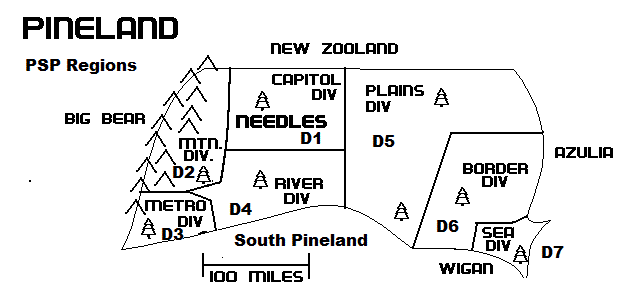

Since the Pineland State Police have regional substations,
the first way to ensure adequate state wide radio coverage is to divide the entire state
into different RADIO ZONES,
and establish in each RADIO ZONE a regional Dispatch Center with its own base radio transmitter.
Each Dispatch Center is responsible for all the radio traffic in its own RADIO ZONE.
Wide area systems tend to be Analog FM, LOW or HIGH Band VHF.
1) analog FM receives suboptimal fringe signals better than Digital modes.
2) VHF is a longer range band compared to UHF.
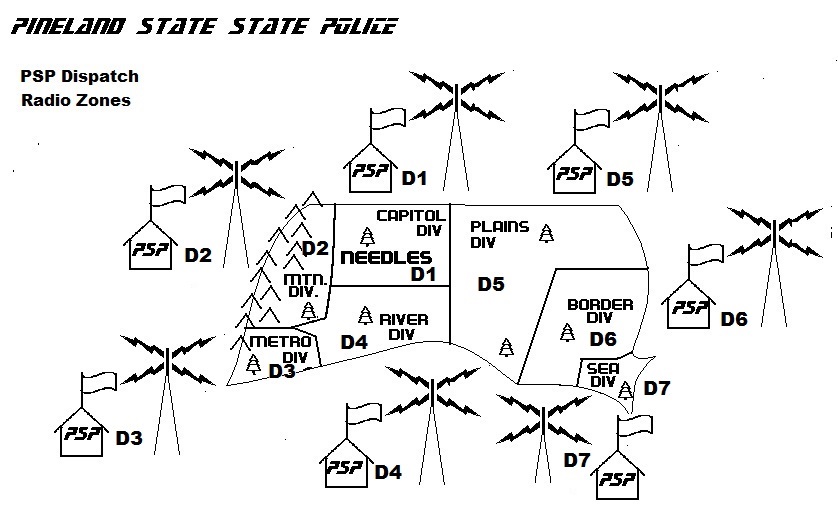
This configuration is called:
MULTI-- SITE SIMPLEX.
In this type of system every base and mobile shares the same
frequency and every unit can hear every other unit and base station within range.
Each RADIO ZONE dispatch center has a BASE radio station.
Each RADIO ZONE has a block of unique unit numbers assigned to it.
Each mobile unit in a RADIO ZONE has a unique unit number.
These unit numbers allow the dispatchers to become familiar with, and quickly "hear" radio traffic from units that belong to their radio zone.
PSP Radio Number System
| PSP Division | Mobile unit numbers | | PSP Division | Mobile unit numbers |
|---|
| Executive Protection | 01-99 | | River D4 | 501-599 |
| HQ SBI | 101-199 | | Plains D5 | 601-699 |
| Capitol D1 | 201-299 | | Border D6 | 701-799 |
| Mountain D2 | 301-399 | | Sea D7 | 801-899 |
| Metro D3 | 401-499 | | State Park Police | 901-999 |

This SIMPLEX configuration has an advantage which is also a major drawback:
Radio Zone Base stations can communicate directly with each other by merely calling another Radio Zone
base station as if it were just another mobile,
but Base stations with their superior antenna systems,
also hear a lot of
radio traffic from other Radio Zones, that is not directed to them from nearby base stations, and other base station's mobiles.
Dispatchers have to waste a lot of time listening to radio traffic most of which does not concern them.
This diverts the dispatcher's
time and attention from other important tasks.
.

To reduce the amount of unwanted radio traffic heard from other RADIO ZONES,
a "Continuous Tone Coded Selective Squelch" (CTCSS) is installed in each base and mobile radio of the Radio Zone.
CTCSS is a system of standardized, subaudible tones that are added into a radio's audio signal
transmitted by the radio.
If a radio with CTCSS, receives a signal that does not have the proper CTCSS tone, it will not
open the audio squelch, and no sound will come out of loudspeaker.
CTCSS also prevents radio static and random noise from being heard.
Each RADIO ZONE has its own unique CTCSS tone.
A different tone for each Radio Zone ensures that the Radio Zone base station and its units only hear each other.

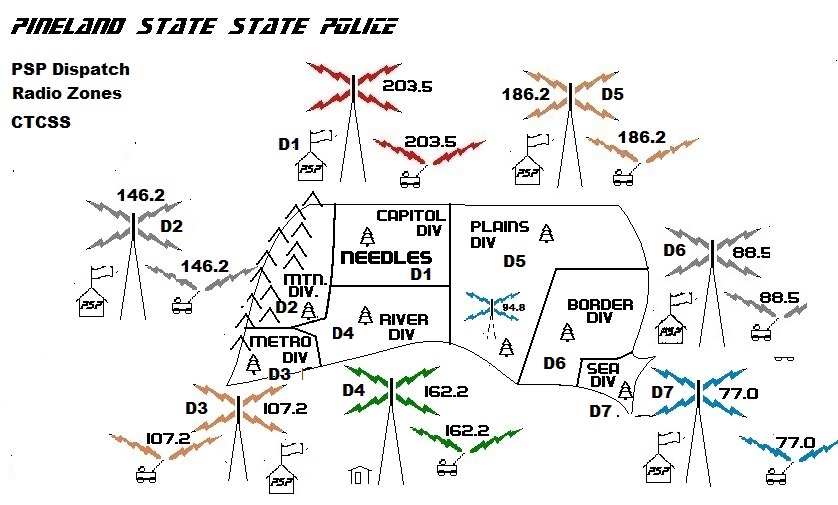
Every base and mobile in a RADIO ZONE has the same CTCSS,
but different RADIO ZONES have different CTCSS tones.
This is called:
MULTI-SITE-- SIMPLEX-- MULTI-CTCSS
Radio Zone Base stations can communicate directly with each other by switching their
base radio CTCSS to the tone of the station they wish to contact.
To allow mobiles to work in different RADIO ZONES, several different CTCSS tones are installed in mobile radios
with some sort of selector switch.
For units that work in multiple different Radio Zones,
many agencies try to make channel and CTCSS selection easier and more user friendly,
by purchasing multiple channel radios for their mobiles, installing a different CTCSS tone in each "Channel".
They label each "channel" with the number of it's associated RADIO ZONE.

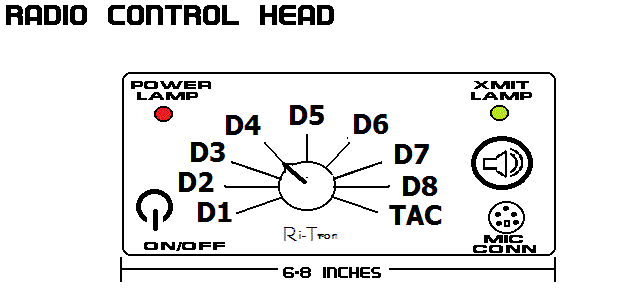
PSP Radio ZONE CTCSS Frequencies
| PSP Division | CTCSS | PSP Division | CTCSS |
|---|
| Interzone | CSQ | River D4 | 162.2 |
| TAC | CSQ | Plains D5 | 94.8 |
| Capitol D1 | > 203.5 | Border D6 | > 88.5 |
| Mountain D2 | 88.5 | Sea D7 | 77.0 |
| Metro D3 | 107.2 | Plains Remote | 186.2 |

One drawback with MULTI-SITE SIMPLEX MULTI-CTCSS systems, is that since ALL units share just one radio
frequency,
neighboring RADIO ZONE bases stations and mobiles will interfere with each other,
If mobiles in one zone can't hear the radio traffic from a neighboring RADIO ZONE,
they will not know that they are transmitting at the same time as other units
these "collisions" of transmissions, will block out transmissions in another zone.
This means that as the amount of radio traffic in the system increases,
more collisions occur, and interference increases.
Eventually, interference from collisions to a point where the usefulness of the entire system degrades to an unacceptable level.
More and more messages are delayed, garbled, or even lost completely.

To reduce collisions, interference between Base Stations, neighboring RADIO ZONES are placed on different,
RADIO FREQUENCIES.
Because the number of RADIO FREQUENCIES is limited,
the FCC will not license a large number of radio RADIO FREQUENCIES to one user agency.
This means that the same RADIO FREQUENCY will have to be reused in more than one RADIO ZONE.
The number of RADIO FREQUENCIES used
is just enough so that RADIO ZONES, that border each other,
will NOT use the same RADIO FREQUENCY.
When a Wide Area Radio System becomes this sophisticated,
Two additional discrete RADIO FREQUENCIES are licensed on a
state Wide basis.
one to be used as a "TAC" or "Common" channel, and one as a "Inter Zone" channel.
"TAC" channels are used by mobile units close to each other, to coordinate activities.
and "Inter Zone" Channels are radio frequencies are used to pass messages between Dispatch Centers.
Often "Inter Zone" channels are licensed to every law enforcement agency dispatch center in the state,
and are used to communicate with local sheriff and police dispatch centers.

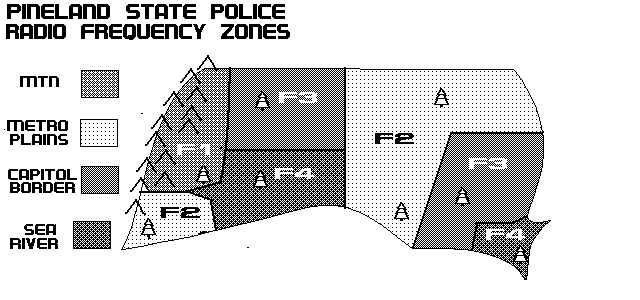 This type of system is known as:
This type of system is known as:
SIMPLEX-- MULTI FREQUENCY-- MULTI CTCSS
CTCSS is retained,
No two Radio Zones on the same frequency, use the same CTCSS frequency.
CTCSS is retained to supress radio static, random radio noise,
and interference from other radio systems that use the same frequencies.
A typical statewide radio system channel line-up looks like this:
PSP Radio VHF LOW BAND Frequencies
| PSP Division | Frequency | CTCSS | PSP Division | Frequency | CTCSS |
|---|
| Interzone | 42.46 | CSQ | River | 42.24 | 162.5 |
| TAC | 42.16 | CSQ | Plains | 42.12 | 94.8 |
| Capitol | 42.86 | 203.5 | Border | 42.86 | 88.5 |
| Mountain | 42.50 | 88.5 | Sea | 42.24 | 77.0 |
| Metro | 42.12 | 107.2 | Plains Remote | 42.56 | 186.2 |
PSP Radio VHF HIGH BAND Frequencies
| PSP Division | Frequency | CTCSS | PSP Division | Frequency | CTCSS |
|---|
| Interzone | 155.190 | CSQ | River | 155.460 | 162.5 |
| TAC | 155.820 | CSQ | Plains | 155.475 | 94.8 |
| Capitol | 155.260 | 203.5 | Border | 155.260 | 88.5 |
| Mountain | 155.715 | 88.5 | Sea | 155.460 | 77.0 |
| Metro | 155.475 | 107.2 | Plains Remote | 154.875 | 186.2 |

Sometimes after Wide Area Radio System RADIO ZONES are established,
there are still "dead areas"
in various parts of a RADIO ZONE.
These "dead areas" are due to any one of a number of factors:
the RADIO ZONE is still too big,
parts of the RADIO ZONE are over the horizon,
mountains are in the way,
or big buildings in a city
block the radio signals.
Creating new subregional RADIO ZONES, and establishing a new Dispatch Center,
is not an effective response.
Due to terrain, the remoteness of the needed transmitter site,
or lack of local personell to operate a new Dispatch Center.
it may be too expensive to establish a new subregional Dispatch Center.
Instead, several different methods are used.
An agency in another state may be contracted to provide dispatch service in areas that border on other states.
An example of this is in Northern New Mexico
the Colorado DTRS system services New Mexico agencies.

In areas where the RADIO ZONE Base Station or the mobiles cannot hear each other,
an unmanned REMOTE BASE is established .
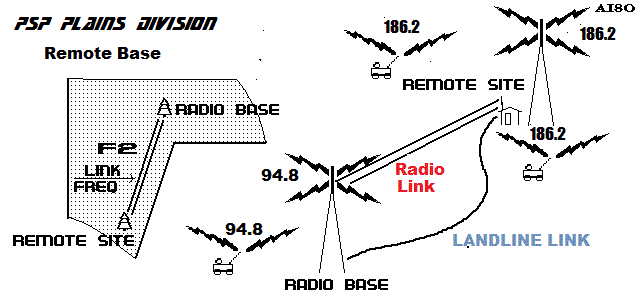 A REMOTE BASE in the "dead area" consists of a transmitter/receiver on a discrete RADIO ZONE frequency,
A REMOTE BASE in the "dead area" consists of a transmitter/receiver on a discrete RADIO ZONE frequency,
and a REMOTE LINK transmitter/receiver relaying signals to the RADIO ZONE regional Dispatch Center.
The REMOTE BASE Radio Channel is installed in the mobile radio as if it was just another RADIO ZONE.
Typically a REMOTE LINK is microwave frequency radio link;
but, telephone landlines, radio frequency links on 72 MHZ, and UHF frequencies have been used.

Home Top
Scanner Home Page
This page was created by Dan Yemiola AI80.
E-Mail any comments or corrections to:AI8O
















